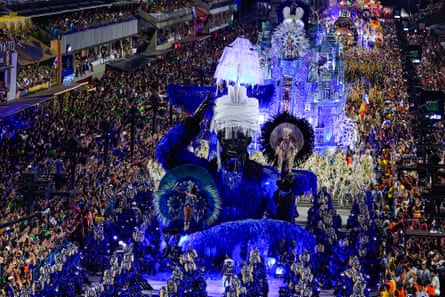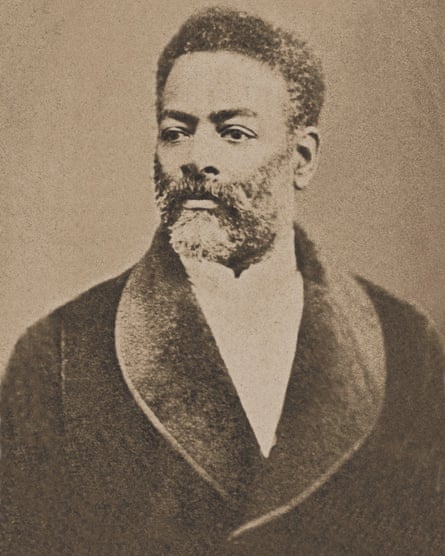B
Born in 1830 to an enslaved African woman who managed to escape and was involved in rebellions, Luiz Gama challenged destiny and the Brazilian empire to become the first Black attorney in the country and a prominent advocate for abolishing slavery.
At the age of 10, Gama’s father, a nobleman from Portugal, sold him into slavery without legal permission in order to settle his gambling debts. As Gama grew into a young adult, he gained his freedom and acquired the ability to read. He then pursued writing, became an intellectual, and taught himself to be a lawyer. Gama established newspapers that advocated for the abolition of slavery and utilized the legal system to assist in freeing over 500 enslaved individuals. Unfortunately, Brazil did not abolish slavery until 1888, six years after Gama’s passing.
After almost 150 years, the fight that Gama symbolized has become the main focus at Rio de Janeiro’s carnival through the official procession of Portela, a renowned samba school in the city.

This year, Portela’s samba-enredo theme song was inspired by Ana Maria Gonçalves’ acclaimed novel, Um Defeito de Cor, which explores the lasting impact of slavery in Brazil through the fictionalized story of Luiza Mahin (known as Kehinde in the book), the mother of Gama. The song, also titled Um Defeito de Cor, portrayed Gama recounting his mother’s courageous resistance in stirring lyrics that were sung by 2,800 performers and witnessed by approximately 70,000 spectators during the school’s 67-minute performance on Monday night at the Sambadrome.
Fábio Pavão, the president of Portela, stated that by honoring Luiz Gama, they are reminding a significant portion of the population of their history, origins, and roots, which should never be forgotten.
This is a history that was long silenced in the majority-Black country. “The Brazilian state buried Gama’s work,” said Bruno Lima, a researcher at the Max Planck Institute for Legal History and Legal Theory in Frankfurt who started studying the abolitionist as a teenager two decades ago.

In the past few years, Gama has become more recognized as Brazil has begun to acknowledge its history. In 2018, he was honored by being included in the Book of Brazilian Heroes and Heroines (Mahin was added the following year). A collection of his writings, edited by Lima, has been released and a room at the University of São Paulo’s law school has been named after him. This is significant because Gama was not able to officially attend the university due to his race.
He is now being honored in the most famous event on Earth, as Portela’s intricately planned parade showcased four different portrayals of Gama on extravagant floats.
Lima, who will release a book about the man he regards as “one of the most influential thinkers of our era” this month, has high hopes that Portela will elevate Gama’s status in the realm of popular historical understanding.
Carnival parades, with their elaborate displays and scantily clad performers, have long served as a platform for celebrating Afro-Brazilian heritage and bringing attention to marginalized narratives.
According to Mauro Cordeiro, a carnival researcher at the Federal University of Rio de Janeiro, Samba schools have a historical tradition of educating the public. They are successful in bringing attention to little-known figures and narratives.
According to him, samba schools are essentially political groups and their parades serve as a platform for current discussions.
This year, over half of the top schools in Rio chose to center their samba songs around Afro-centric themes. According to Cordeiro, while this is not uncommon, it highlights the significance of these narratives in the festivities. Some examples include Estação Primeira de Mangueira, who honored beloved singer Alcione with a samba titled “A Negra Voz do Amanhã” (The Black Voice of Tomorrow), and Paraíso do Tuiutí, which depicted the story of João Cândido, a sailor who led a rebellion against floggings in 1910 and whose descendants are now seeking reparations from the Brazilian government.

Portela has also participated in these discussions beyond carnival. In November of last year, the school organized a public meeting to address reparations for slavery. During this meeting, the top bank Banco do Brasil issued an apology for its involvement in the slave trade after an investigation into its historical connections.
Last week, there was a lot of discussion about these problems within Portela’s headquarters, which are decorated in blue and white. Many people gathered at the headquarters in Rio’s northern suburbs for a final practice. Roseli Santos, a lifelong member of Portela at 61 years old, expressed the significance of this year’s theme to her as a Black person, as it represents her race. She then joined other performers wearing matching T-shirts with the title of the samba, “A Colour Defect.”
The sound of drums and cymbals reverberated through the hall, creating an energizing rhythm. In unison, the dancers raised their arms and chanted the chorus in honor of Mahin, Gama, and their joint fight: “Cheers to Kehinde! Your legacy endures! Your community is liberated! Your son has triumphed!”
Source: theguardian.com


















